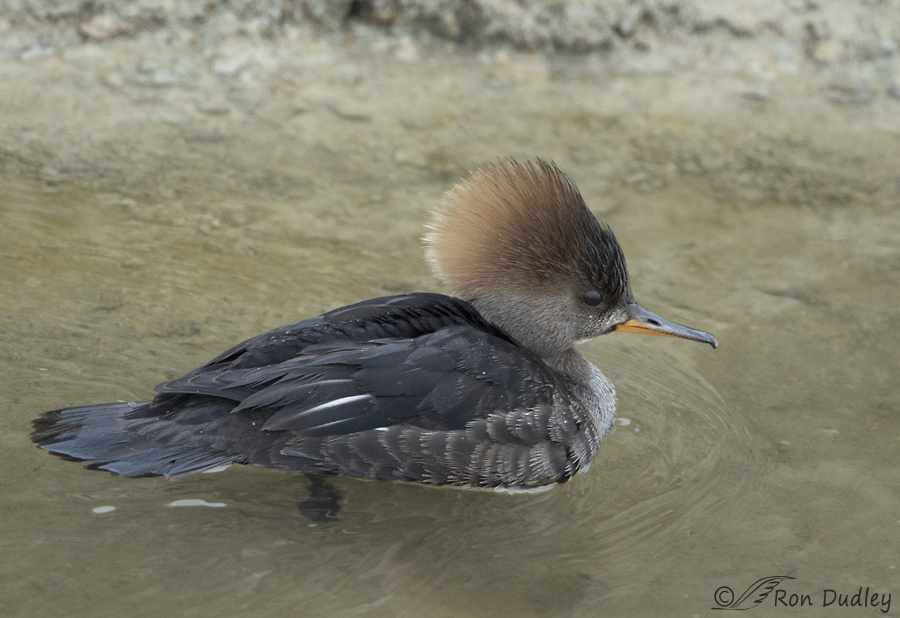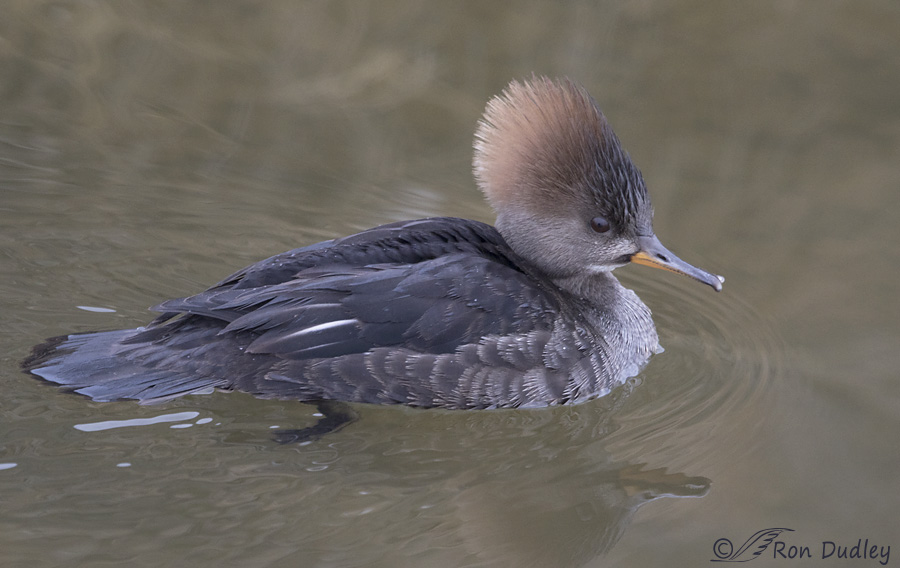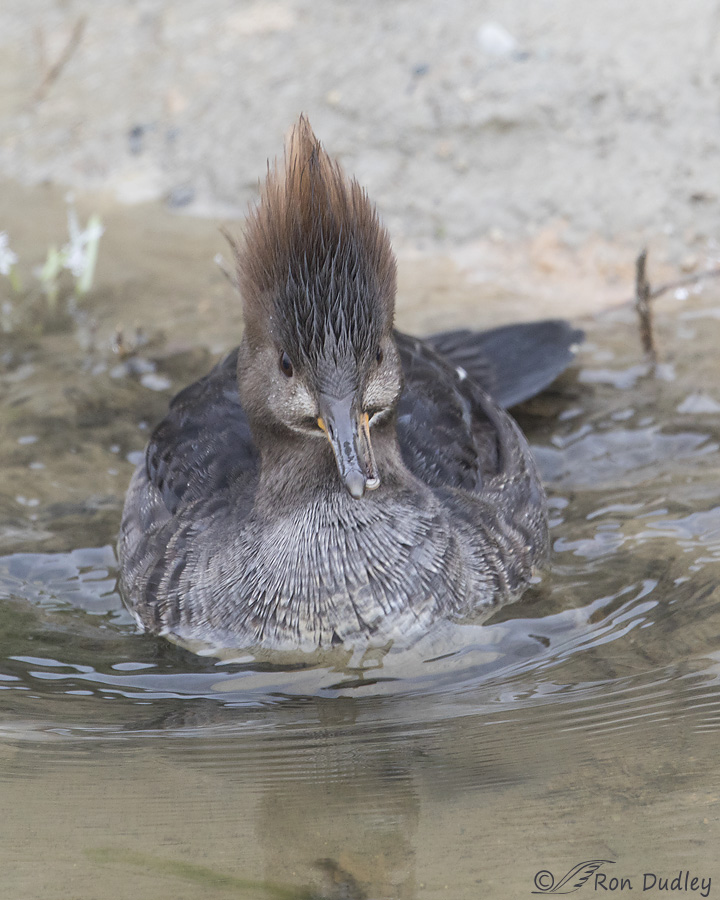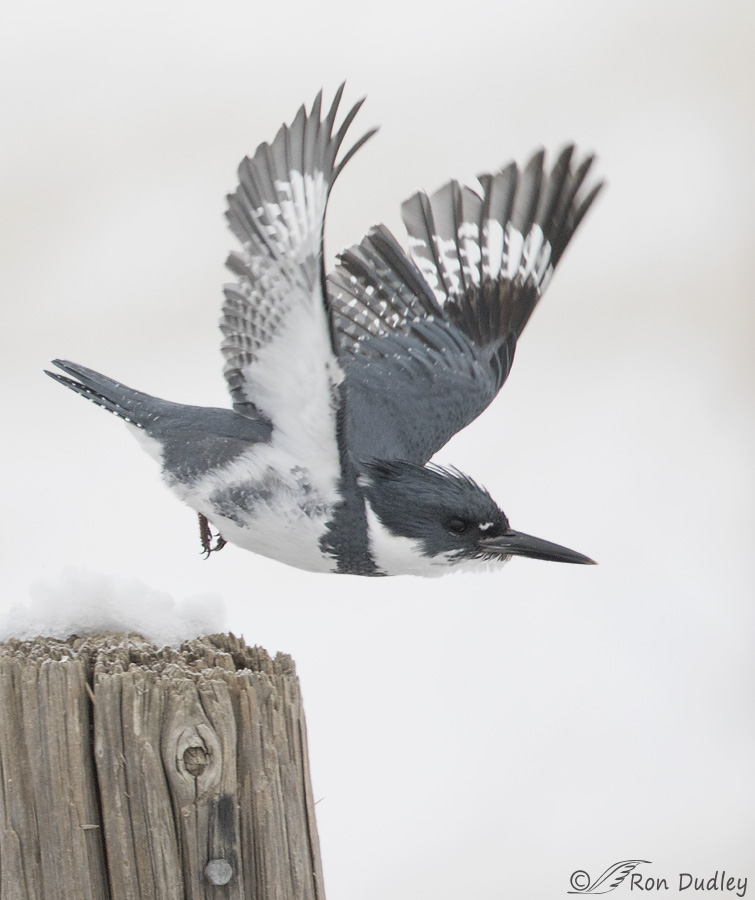I don’t think I’ve seen this condition before, in any species.
Yesterday morning at Farmington was a bust for me and I’ll blame it on the weather forecasters. The forecast was for partly cloudy but it was socked in with thick clouds the entire time I was there so because of deplorable light I didn’t get any shots that I like. Zilch. Nada. Not a single one.
I did find a couple of interesting birds though.

1/800, f/5.6, ISO 800, Canon 7D Mark II, Canon EF 500mm f/4L IS II USM + EF 1.4 III Extender, not baited, set up or called in
It’s extremely rare for me to see a Hooded Merganser so even with the deplorable light I couldn’t resist documenting this sighting. To make shooting conditions even worse the bird was in a creek lined with high, steep banks so in the early morning the light was even more dismal down there and the angle on the merganser was steep.
But while reviewing my images at home I noticed something unusual about this bird’s bill that at most angles could barely be seen. Here we only get a hint of it – sharp eyes might notice that the mandible (lower bill) begins to disappear behind the maxilla (upper bill) as it becomes more distal (further away from the body).

1/500, f/5.6, ISO 800, Canon 7D Mark II, Canon EF 500mm f/4L IS II USM + EF 1.4 III Extender, not baited, set up or called in
With the head turned more toward us and an even steeper angle on the bird a little more is revealed. The whitest spot at the end of the bill that at first glance appears to be a water drop is actually the tip of the mandible that wouldn’t be seen above the tip of the maxilla at this angle in a normal bill. We’ll get a much different view of that white spot in the next image.

1/320, f/7.1, ISO 800, Canon 7D Mark II, Canon EF 500mm f/4L IS II USM + EF 1.4 III Extender, not baited, set up or called in
When the bird plopped into the water from the bank it gave me a head-on view that best shows the alignment problem with the bill (even though the image isn’t very sharp – 1/320 sec just isn’t a fast enough shutter speed for these shaky old hands). The alignment issue appears to be fairly drastic. Both the mandible and the maxilla seem to be structurally normal but they’re just badly misaligned.
I’m relatively sure this wasn’t just a momentary misalignment of the bill done deliberately by the bird (if that’s something they’re even capable of doing) because I have many other images that show the same misalignment to one degree or another at different angles.
In the past I’ve photographed a variety of different birds with abnormal bills (examples can be seen here and here) but their bills were always deformed in one way or another rather than misaligned. I’m no veterinarian or rehabber but this bird seems to have a new, to me, variation on the theme and it interested me for that reason.
For those who may be concerned for the welfare of the bird, this merganser seems to have adapted just fine to its abnormality.

1/2000, f/5.6, ISO 1000, Canon 7D Mark II, Canon EF 500mm f/4L IS II USM + EF 1.4 III Extender, not baited, set up or called in
The only other bird of interest yesterday morning was my old friend the male Belted Kingfisher. It was so damned frustrating to get several images like this one that in better light could have been quite good. He took off from the mound of snow on the perch and I got two shots of him lifting off that I would have liked in better light. Shortly after I left the area and went home the sun came out and I’m sure other photographers did much better with this bird than I did.
Bird photography ain’t easy!
Ron
PS – I hope WordPress has its act together by now and sends out the link to this post to my subscribers. Yesterday it didn’t happen…


Can birds move their lower jaw sidewise like mammals are able to do? I would guess so from her survival.
I never watched my chickens or domestic ducks and geese to see if they could do that.
I don’t know, Pam. Don’t think I’ve ever noticed a bird doing that though…
Disturbing…
I’m pretty sure the merganser will be fine, Patty.
Always interesting. Thanks.
Stephen
🙂
I love the shot of your friend the kingfisher. I’m so glad he’s still hanging around. I miss snow quite a bit (except for the shoveling/digging out my car part), so I’m especially delighted — I’m imagining the snowy quiet with just the slight flap of wings as he takes off.
I’m always amazed at the resiliency of animals — both in the wild and those we see at our spca. The other commenters have said it much more eloquently than I. I’m almost embarrassed to admit that my eye has been drawn more to the merganser’s “Don King hair-do” than to the misaligned beak. :/
Ha, don’t be embarrassed by that, Marty! I have the same reaction to the kingfisher’s crest when it’s raised.
So many animals adapt much, much better than we do.
I am glad that the Hooded Meganaser can feed, and hope that the misalignment doesn’t get any worse.
It looks to be providing for itself just fine, EC, so hopefully it will be fine long-term.
One of the things we humans get caught up with is the quest for perfection. In short, we think too much. Those of us who do (or have done) rehab struggle with the idea of which handicaps wild birds/critters can survive with and those they can’t. The birds/critters, on the other hand, adapt to their situation with far greater grace and determination than we humans can muster. They don’t engage in the whining and hand wringing and those other activities that get in the way of them just getting on with it and getting the survival thing done. They seem to get it that there’s a difference between optimal conditions and REQUIRED conditions that can be modified/adapted to make things happen, despite that it’s not the normal/optimal way. We humans can learn a LOT from birds/critters 🙂
Very well said, Laura.
I am amazed by what kinds of deformities birds learn to survive with. I would have no idea except for the photos you post. Mergansers are fun birds to watch – I remember having a pair of them on a pond I lived by at one time. The deformity also reminds me of a couple of young Canada Geese who were injured; the one with the messed up wing survived, but the one whose eyes were injured didn’t. Love the Kingfisher shot, too, even though the light is not good.
Eye injuries can be brutal on birds, Susan but I’m also impressed by how many of them learn to cope with that type of injury.
In rehabilitation, we often have to decide on the releasability of a bird that still has some issue. I wouldn’t have expected that this bird could hunt and feed successfully, and yet it has. I just returned from a “wild Heron hunt”, an attempt to capture a Great-blue that has one wing hanging down. Found it in a tree. Now how in the world did it get itself up there? Found out when it gracefully lifted off and flew symmetrically with ease. Apparently the wing was broken and healed itself in the extended position. The bird could not fold the wing, but it could fly with it. I would not have believed it if I had not watched it. Thank you for posting! I love the beautiful photos, but even more enjoy the things that arouse your curiousity.
Wow, what an amazing story of adaptability, Mikal! Thanks for sharing it. Makes me feel a little better about a few birds I’ve seen “out there”.
And I also enjoyed how skillfully you told that story…
Tough world these birds have to deal with! I wonder if it is genetic or simply an injury. Natural Selection would have taken over if this female wasn’t able to catch food.
Many of the abnormalities we see birds with they have been able to deal with, survive with. I can’t imagine the numbers that don’t survive that we don’t know about.
Dick, when one pays attention it’s amazing how many birds there are out there dealing successfully with injuries and genetic defects. They’re so fragile in some ways but so tough and adaptable in others…
That bill is intriguing. I wonder if it is an injury that didn’t heal correctly.
Could be, Arwen. Or perhaps a congenital defect…
Amazing photos! Disabilities exist in the avian world and apparently can be overcome. Love the Kingy flight shot!
Charlotte
Thank you, Charlotte.
It could be an impact injury. We have seen similar mis-alignments at our rehab centre over the years. Vehicle collisions, etc could cause a fracture to the lower skull area causing the problem.
I wondered about exactly that, Pam – some kind of impact injury. I have alignment problems with my own jaw at times and it’s very painful until it realigns so this bird has my sympathy if it’s in any discomfort. Its behavior seems perfectly normal though.
Made it today! 🙂 Interesting abnormality – it must be able to function with it since it’s “grown”. Kingfisher is a good shot even if the light didn’t cooperate. Of course, I’m always happy just to see a photo of the little devils! 🙂
I got my email too, Judy (yes, I’m a subscriber to my own blog so I’ll know if they go out or not). “Little devils” is right!